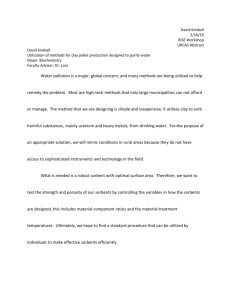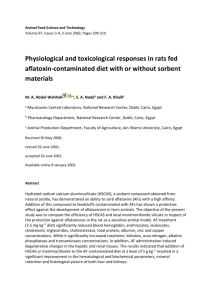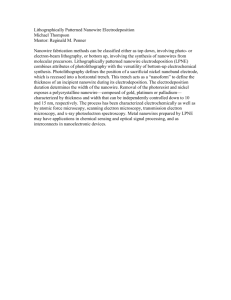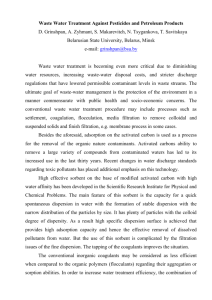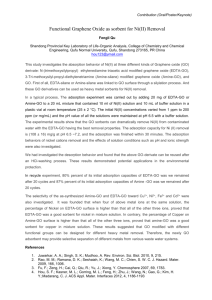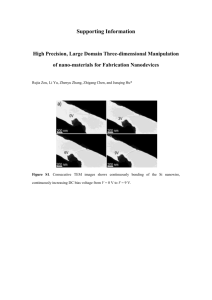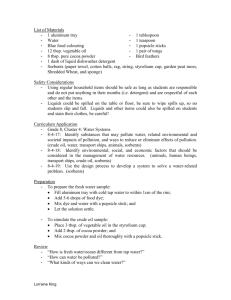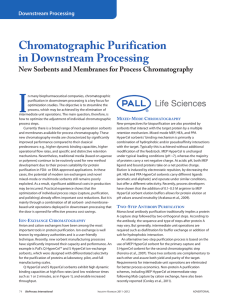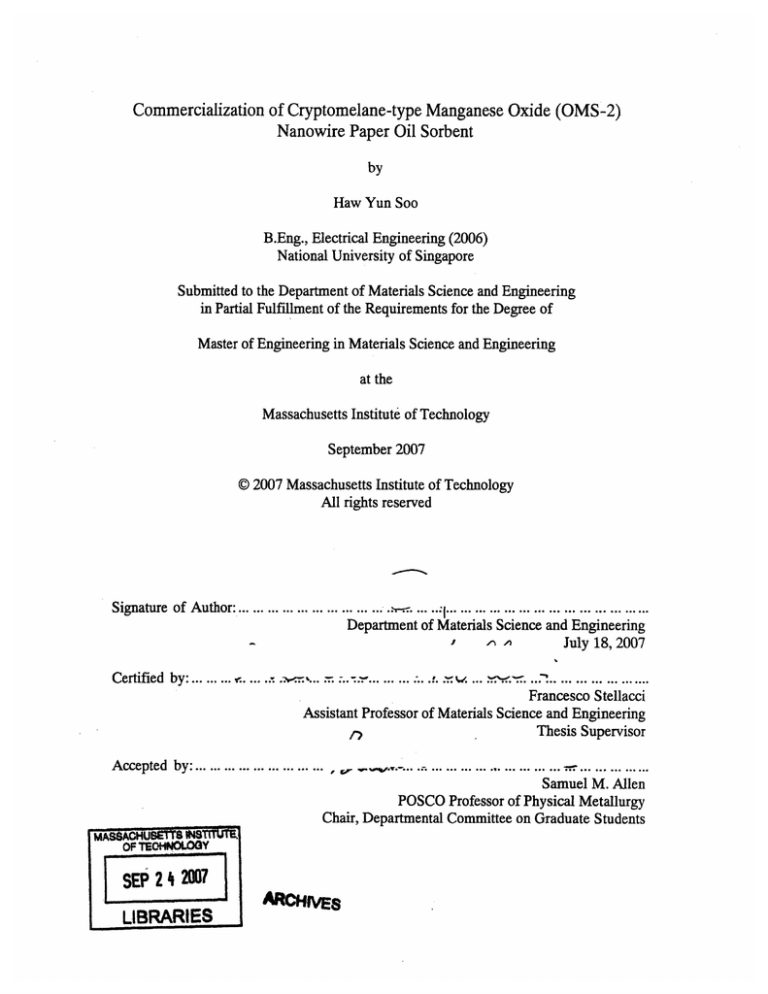
Commercialization of Cryptomelane-type Manganese Oxide (OMS-2)
Nanowire Paper Oil Sorbent
by
Haw Yun Soo
B.Eng., Electrical Engineering (2006)
National University of Singapore
Submitted to the Department of Materials Science and Engineering
in Partial Fulfillment of the Requirements for the Degree of
Master of Engineering in Materials Science and Engineering
at the
Massachusetts Institute of Technology
September 2007
© 2007 Massachusetts Institute of Technology
All rights reserved
Signature of Author:... ......... ... ... ...........
... .........
......... ........ ......
....
Department of Materials Science and Engineering
July 18, 2007
Certified by:......
.... .
. .
...
...
...
...
.....
................
Francesco Stellacci
Assistant Professor of Materials Science and Engineering
Thesis Supervisor
n
Accepted by: ... .........
Samuel M. Allen
POSCO Professor of Physical Metallurgy
Chair, Departmental Committee on Graduate Students
OF TEOHNOLOGY
SEP 2 207
LIBRARIES
ARCHIVES
Commercialization of Cryptomelane-type Manganese Oxide (OMS-2)
Nanowire Paper Oil Sorbent
by
Haw Yun Soo
Submitted to the Department of Materials Science and Engineering
on 18 July 2007 in Partial Fulfillment of the Requirements for the Degree of
Master of Engineering in Materials Science and Engineering
ABSTRACT
Cryptomelane-type Manganese oxide (OMS-2, a group of Octahedral Molecular Sieves)
nanowire paper exhibits interesting properties: reversible wettability, oleophilic while
being hydrophobic, and high thermal stability. These properties open up possible markets
for commercialization. This thesis reviews the market potential of each of these
properties and explores the competitiveness of the nanowire paper in the proposed
markets.
The proposed values of this technology are in its high selective absorbency towards oil,
high performance over cost metric and its high thermal stability. Its thermal stability
enables a thermal desorption type process to regenerate and recycle the sorbent for reuse.
This translates into further differentiation and provides greater value for the users.
Thesis Supervisor: Francesco Stellacci
Title: Assistant Professor of Materials Science and Engineering
Table of Contents
List of Figures .....................................................................................................................
4
List of Tables .............................................................................
...........................
4
Acknowledgm ents........................................................................................................
5
Introduction ........................
6
...................................................................................
Technology .................................................................................................
M arket Identification .................................................
............
6
................................................. 15
Intellectual Property..........................................................................................................
21
Value Proposition..............................................................................................................
24
Cost Analysis ....................................................................................................................
25
Conclusion ..............................................................................................................
33
References.....................................................................................................................
36
Appendix...........................................
37
...............................................................
List of Figures
Figure 1: Schematic representation of the synthesis procedure of MnO 2 Nanowire paper
[2] .........................................................................................................................
7
Figure 2: Nanowire paper structure (SEM image at different magnifications) [2] ............. 8
Figure 3: Nanowire paper structure (TEM image of a single MnO 2 nanowire) ............. 8
Figure 4: Water droplet absorbed into the paper [2] ................................................. 9
Figure 5: High contact angle showing superhydrophobicity [2] ..................................... 9
Figure 6: Reversible wettability [2] .................................................... 10
Figure 7: A series of contact angle and hystersis measurements taken after each transition
cycle [2] .................................................. .................................................... 10
Figure 8: Effect of UV radiation on TiO 2 coated glass, Nature 1997, 388, 431-432.
Copyright 1997 Nature Publishing Group ..................................... ...... 11
Figure 9: (a) Surface contact angle (water droplet) change when voltage is applied. (b)
Experimental set-up for fluid motion induced by application of electrical
potential. Application in nanofludics (bottom). Int. J. Robust Nonlinear Control
2005; 15:785-803. Copyright C 2005 Jon Wiley & Sons. Ltd....................... 12
Figure 10: (A) Oil absorption capacities of nanowire paper for a range of organic solvents
and oils. (B) and (C) Absorption of surface gasoline by nanowire paper [2] .... 13
Figure 11: Industrial Oil absorbent pads and rolls for oil leaks and spill clean up. The
Gases and Welding Distributor; May/Jun 2003; 47, 3; ABI/INFORM Trade and
16
Industry pg.30. ...................................................................................................
Figure 12: Close-loop Absorbent Recycling scheme...............................
........ 25
Figure 13: Absorption cost (dollar per kg of absorbed oil) of various oil absorbents and
the nanowire paper........................................................28
Figure 14: Absorption performance of various absorbents (times its weight).............. 28
Figure 15: Thermal Desorption Process for Treating Contaminated Soil ..................... 30
Figure 16: Thermal Desorption-Unit Cost vs. Quantity of Soil Treated (with 68-percent
Confidence Interval.....................................................31
List of Tables
Table 1: Test results for CDS with sorbents ........................................
Table 2: Cost analysis table to produce 1 mol of MnO2 ............ . .. . . .........
.
Table 3: Absorption performance of oil absorbent pads..................................
.......... 21
...............
26
..
..... 27
Acknowledgments
The author would like to thank Jikang Yuan, Dr. Xiaogang, Liu and Dr. Francesco
Stellacci for their invaluable help in the understanding of the Cryptomelane-type
Manganese Oxide (OMS-2) Nanowire Paper technology.
The author would also like to thank the following professors and industry contacts for
their time and invaluable insights on the various topics:
* Professor F. Michael Saunders, Head of the Department of Environmental
Science and Engineering (ESE), Faculty of Engineering, National University of
Singapore (NUS)
* Professor Farooq, Shamsuzzaman, Department of Chemical and Biomolecular
Engineering, Faculty of Engineering, NUS
* Associate Professor Jeffrey Philip Obbard , Deputy Head (Research), ESE,
Faculty of Engineering, NUS
* Professor Ng Wun Jern, ESE, Faculty of Engineering, NUS
* Associate Professor Bai, Renbi, ESE, Faculty of Engineering, NUS
* David Ziegler, PE, Business Manager, Contech Stormwater Solutions, Inc.
* Shelby Hull, Stormwater Consultant, Contech Stormwater Solutions, Inc
Introduction
Self-assembly of ordered structures from simple systems has been of great interest in the
material science field'. These structures can be used in many different fields-as
catalysts, sensors, templates for other processes and in photoelectronics and separation
processes.
Here, one of such structures showed interesting wetting behavior that opened up a
multitude of application potentials. The Cryptomelane-type Manganese oxide (OMS-2, a
group of Octahedral Molecular Sieves) nanowire paper was self-assembled through a
thermal process with precursors. The Manganese Oxide (MnO 2) Nanowire paper is
reversibly superhydrophobic and hydrophilic, has high oil absorbency in its hydrophobic
state and also has high thermal stability.
This evaluation aims to find the best commercialization path (if any) for this technology.
First, the technology is evaluated and its differentiating points listed out. An
understanding of the maturity of the technology field was also undertaken to better
identify its market potential. Secondly, possible markets were identified and
commercialization opportunity discussed. Thirdly, an evaluation of the markets and
competition was undertaken. Fourthly, an intellectual property analysis was done. Next, a
cost analysis was presented together with a value proposition for the technology with
regards to the chosen markets. Finally, a conclusion was made on how to proceed.
The terms sorbent and absorbent are used interchangeably throughout the thesis.
Technology
The MnO 2 nanowire paper is prepared through mixing stoichiometric mixture of
potassium sulfate, potassium persulfate, and manganese sulfate monohydrate in 3:3:2
1Jikang Yuan, Kate Laubernds, Josanlet Villegas, Sinue Gomez, and Steven L. Suib, Spontaneous
Formation of Inorganic Paper-Link Materials
ratio dissolved in 70ml distilled and deionized water (DDW). The mixture was heated in
an oven in a sealed Teflon vessel for four days at 2500 C. Next, the rigid solid was resuspended in 800ml DDW and stirred overnight to produce a wool-like suspension. The
water was then removed and the paper-like membrane was cast on a Teflon substrate and
0 C.The nanowire paper can then be peeled off.
heated for 24 hours at 85
Paper-like
Sfree
Hydrotherm
Precursors
-
teatment
10
standing membrane
Stiring
OLverflight
Substrate
Figure 1: Schematic representation of the synthesis procedure of MnO 2 Nanowire paper
[2]
The fabrication procedure is relatively simple and has a 50% yield. It is also highly
scalable in terms of the size of the nanowire paper. The long processing time may be a
problem in an industrial process, but batch processing could be used to overcome this.
The paper-like membrane consists of layers of cryptomelane-type manganese oxide
(OMS-2) fibers. These fibers are made out of self-assembled nanowire bundles several
hundreds of micrometers long and interpenetrate within the membrane to form a porous
network. This porous network provides the high surface area for its superabsorbency
property.
Transmission Electron Microscopy (TEM) image of a single nanowire showed a diameter
of 19nm (Figure 3).
Figure 2: Nanowire paper structure (SEM image at different magnifications) [2]
Figure 3: Nanowire paper structure (TEM image of a single MnO 2 nanowire)
The MnO 2 nanowire paper has some differentiating properties:
1) Reversible wettability (superhydrophobic and superhydrophilic)
2) Superhydrophobicity and oleophilicity
3) High thermal stability
4) Simple fabrication
1. Reversible wettability
The paper is superhydrophilic in its as-fabricated state. The wetting time of 0.05s is
reproducible until the saturation point is reached at a particular location (Figure 4).
Figure 4: Water droplet absorbed into the paper [2]
To convert it to a superhydrophobic material, the paper is coated with silane at 2300 C
through Chemical Vapor Deposition (CVD). The modified nanowire paper becomes
superhydrophobic with high contact angle of 172 +10 (Figure 5).
Figure 5: High contact angle showing superhydrophobicity [2]
This process is reversible as the hydrophobic coating can be removed by heating the
paper at 3900 C. This reversible process was tested up to 8 times (Figure 7) and showed
good repeatability. The high wettability change is highly desirable in applications that
will be discussed below. However, the way at which this is achieved limits its
applicability
Silane coating
(230 oC)
kh
Heating
(390 oC)
Figure 6: Reversible wettability [2]
4O•
'"'
0
160
-
itnS140
-
~
U
0
-8
0
-72
-6
U)
CD 120S100-
-5
t
loo
80-
0
40-
* Contact angle
-4
* :Contact angle hysteresis - -3
M
'<
-2C
- l)
200-
0
0
1
2
3
4
5
6
7
8
o
9
Number of surface coatings
Figure 7: A series of contact angle and hysteresis measurements taken after each
transition cycle [2]
This interesting property falls under the area of controlled switchable surfaces. Currently,
there are a few ways of achieving this:
i) Photoillumination
Photosensitive Titanium oxide (TiO 2) and Zinc oxide (ZnO) inorganic materials are the
most studied semiconductors with reversible surface properties. For example, TiO 2 has a
native water contact angle of 72±1 and after UV illumination, it exhibits 0± 1 water
contact angle. The hydrophilic surface can be converted back to its native hydrophobic
surface by long-term storage in the dark. Other materials capable of exhibiting this
property is Spiropyrans, an organic material that undergo a reversible transition between
closed nonpolar form and highly polar form when irradiated with UV and visible light.
However, the contact angle change is small.
Figure 8: Effect of UV radiation on TiO 2 coated glass, Nature 1997, 388, 431-432.
Copyright 1997 Nature Publishing Group
ii) Thermal treatment
This class of material is characterized by the lower critical solution temperature (LCST).
In poly(N-isopropylacrylamide) (PNIPAAm), this temperature is about 32-33°C. The
polymer chains hydrates to form expanded structures in water when the temperature is
below its LCST, but the compact form that it takes above LCST dehydrates the structure.
The wettability change associated with this can be from 0' to 149.30 on a rough surface.
This property shows high promise because with a change from room temperature to body
temperature, a high change in wettability can be induced.
iii) Surrounding media driven
This is a solvent driven wettability change. For example, a Y-shaped molecule attached
to a silicon surface with one end of the Y attached to a hydrophobic polystyrene (PS)
polymer, and the other to a hydrophilic polyacrylic acid (PAA) polymer chain exhibits PS
wettability behavior when treated with a PS solvent. For example, toluene is a good
solvent for PS but not for PAA. After the solvent treatment, the surface becomes
predominantly PS and hence hydrophobic. The same goes with treating with a PAA
solvent-becomes hydrophilic. The water contact change can be from 250 to 1150 on a
flat surface.
iv) Electric field response
One of the more mature technologies is the surface tension change due to electrical
actuation. Teflon is a hydrophobic material when no voltage is applied, but when a
voltage is applied, the silicon dioxide dielectric below is polarized and the water/Teflon
area is maximized to minimize electrical energy. Figure 9 (b) illustrates a method of fluid
motion by applied electrical potential. When the electrode adjacent to the droplet is
turned on, the surface tension is lowered and the droplet is drawn to the right.
ilI
-it
no
voltage
voltage=
A
e
30V
.€
V
++.
................
(8)
r
+++•:+.+•.+
(b)
I
~
BI
.
-'
Figure 9: (a) Surface contact angle (water droplet) change when voltage is applied. (b)
Experimental set-up for fluid motion induced by application of electrical potential.
Application in nanofludics (bottom). Int. J. Robust Nonlinear Control 2005; 15:785803. Copyright C 2005 Jon Wiley & Sons. Ltd.
These are only a few of the possible ways of changing material wettability property. This
area of research is still at its infancy and researchers are focused on basic research of
functional surfaces. Applications of this type of technology include nanofluidics,
bioanalysis, bioseparation, drug delivery, etc. They fall under the broader domain of
BioMEMS. The BioMEMS industry is slowly maturing with more and more products in
the market. BioMEMS products have the potential of being disposable, ensuring a
constant demand. However, evidence of switchable surfaces being used in a commercial
product in the mentioned areas has not been found. This technology is generating a lot of
interests but the kinks have not been ironed out and development activities are minimal.
Even though the nanowire paper falls under this category of controlled switchable
surfaces and has a wider contact angle change, its surface property change involves the
use of CVD deposition of silane at relatively high temperature. This process is
impractical in applications like nanofluidics where photoinduced wettability and electric
field response have a clear advantage in fluid control in the nano scale. Therefore, the
market for the nanowire paper in this area is not apparent.
2) Superhydrophobicityand Oleophilicity
The nanowire paper has high oil absorbency (up to 23 times its weight) while showing
superhydrophobicity as shown below.
A
1800
1600
c 1400
S1200.
0looo
800
200
"L4
2•"
.e/
PIP
0
P/· h
Sunoco
(regular
with Oil
Figure 10: (A) Oil absorption capacities of nanowire paper for a range of organic solvents
and oils. (B) and (C) Absorption of surface gasoline by nanowire paper [2]
This suggests that it could be used as an oil sorbent. The paper-like form makes it easy to
be stored and applied. However, the oil sorbent market is almost like a commodity
market and has minimal differentiation. Three main types of sorbents are: inorganic
mineral sorbents, synthetic sorbents and organic sorbents. Inorganic sorbents include
zeolites, sorbent clay and silica. They are usually in particulate/granular form. Sorbent
clay was widely used in the industry to clean up spills in the 1990s. However, it is less
widely used now because of health concerns, high waste generation and intensive labor
use. Zeolites are hydrophobic alumino-slicate minerals that have an open honeycomb
structure. Their structure gives rise to their oil absorbency property and provides a large
adsorption area. Zeolites have high thermal stability up to 1300 0C and can be regenerated
with steam. They are mainly used as industrial floor absorbent and oil spill control.
Synthetic sorbents include the most widely used industrial sorbent-polypropylene and
polyurethane. They come in all shapes and sizes. They can be found in continuous (pads,
rolls, booms) or granular/particulate form. Their absorbency varies with packaging and
the density and arrangement of the polypropylene fiber (10-20 times their weight). As
with most synthetic products, they are not biodegradable and poses disposal problems if
recycling services are unavailable.
Finally, organic sorbents are biodegradable materials like straw, wood fiber and cotton.
They are usually used in oil spill events because they are cheap and easy to deploy and
collect. Their absorbency performance is usually worse than the other two but they are
cheap and made from renewable natural materials. The discussion on how to enter this
market will be presented over the next few chapters.
3) High Thermalstability
The nanowire paper is stable at up to 3800C, making thermal treatment to regenerate the
sorbent possible. Light sorbed oil can be driven off and the sorbent paper reused. Again,
the discussion for the value proposition for this will be taken up in the following chapters.
4) Simplefabrication
The key to entering a not so differentiated market is the play on cost. Therefore, it is
important to have a simple and cost efficient fabrication process as a pre-requisite.
Market Identification
Several markets are apparent from the discussion of the nanowire paper's differentiating
points, and the applications of its reversible wettability property have already been ruled
out. Therefore, the following discussion will focus the paper's oleophilicity (while being
superhydrophobic) and its market applications. One obvious market opportunity is the oil
spill containment/recovery market. The paper would be especially useful during spills on
water because it is selectively absorbent. However, sorbent use is only one of the ways of
recovering and containing the oil. Most ocean oil spill recovery is performed through
mechanical devices like skimmers, booms, etc. In some cases, dispersants are also used to
diffuse the oil into the ocean. Sorbent use is usually restricted to recover the last bit of oil
from the water surface after mechanical recovery. Furthermore, because of the scale of an
oil spill, cost is the main consideration. Thus, people are using cheap natural sorbents like
wool that can be easily deployed and collected. The nanowire paper may not fair well in
absorbing heavy hydrocarbons because they may clog up the nanowire membrane. Also,
because of its paper-like form, it may not be easily deployed and recovered in rough seas.
The next possible market is the industrial sorbent market. This market deals with cleaning
up of industrial spills that include oil (mostly), solvents, etc. Industrial sorbents come in
all shapes and forms: booms, pads, wipes, and even floor paddings. They can be grouped
into three main types: Hazmat sorbents, universal sorbents and selective sorbents.
Hazmat sorbents deal with soaking up harzardous liquids like acids and bases. Universal
sorbents as the name suggests, absorb all liquids and is useful for water, oil and solvent
leaks. Selective sorbents are sorbents that absorb for instance more oil than water. This
market is almost commoditized because cost plays a major part in deciding which sorbent
to use. Most manufacturers have a product line that spans mainly the universal and
selective categories in various forms. However, recent developments create an opening
for entry.
The other market that will be discussed is the stormwater Best Management Practice
(BMP) device market. Stormwater is water that accumulates after a storm and that
includes runoffs from roads. The stormwater drainage system includes roadside drains
and drains at industrial facilities that do not go through a sewer or treatment system.
However, there is an increasing interest in stormwater treatment. The Environment
Protection Agency (EPA) identified stormwater discharges as a significant source of
water pollution: 13% of impaired rivers; 21% of impaired lakes, ponds, reservoirs; and
45% of impaired estuaries. Legislative requirements have led to the increase of the use of
BMP devices that prevent pollution from going into the stormwater. Oil absorbents come
into the picture because the inclusion of sorbents in BMPs can reduce oil and grease
contaminants in stormwater 2.
IndustrialSorbent Market
EPA estimates that 1.1 billion gallons of used oil from equipments have to be cleaned up
every year3 (1993). This market is a $500 million/year market (North America) with a
30% annual growth (EPA, 1998). If that growth rate is constant, that would make it a
$5.3 billion/year market in 2007. This is certainly a large market to go into, but how do
provide value to this market and thus enabling the extraction of revenues/profits?
Ai
Figure 11: Industrial Oil absorbent pads and rolls for oil leaks and spill clean up. The
Gases and Welding Distributor; May/Jun 2003; 47, 3; ABI/INFORM Trade and
Industry pg.30.
There is a trend towards waste minimization because of the rising cost of disposal of used
sorbents and stricter regulations. Landfill costs are rising--$300-$500 per drum (55 gal or
1001bs) (1994) because of landfill related environmental issues and space constraints.
2 Michael
K. Strenstrom, Oil and Grease Removal by Floating Sorbent in a CDS Device, 1998
3 Susan Avery, Buyers socked with regs, sop up more sorbents, Purchasing, December 16, 1993
EPA and state authorities have also come up with policies on disposal of sorbents that
made disposal more complicated and costly.
Floor cleaning sorbent clay (particulate form) was once the main sorbent used because it
is cheap. However, because of certain health issues, high labor usage and most
importantly the large amount of waste generated, the industry moved away from clay.
This created an opening for more expensive synthetic sorbents like polypropylene, which
moved on to be one of the most used industrial sorbent.
As a result of these developments, there is a greater market for more expensive and
recyclable/reusable sorbents. There are several ways of dealing with sorbent waste:
i)
Landfilling-There is long-term liability to the generator of the waste, and
landfill cost is high
ii)
Incineration--Can be costly and there is liability associated with the ash and
air emission produced, the energy could be recovered but obviously the
sorbents can not be reused
iii)
Laundering-Can be costly and generates a waste water stream, but sorbents
can be reused
iv)
Wringers-Spins used sorbents to remove certain amount of oil. It can be time
consuming, messy and not that effective as some percentage of oil will still be
in the sorbent. However, a portable unit could be purchased to be used at a
user site for convenience
v)
Bioremediation--Oil digesting microbes can be incorporated to some sorbents
to enable bioremediation upon disposal (for example, Patent 5492881). Again,
this method does not permit reuse of sorbents.
vi)
Closed-loop recycling-Producers of the sorbents also offer recycling services
through improved environmentally friendlier means. This method is more cost
effective and eliminates long-term liability
Several companies are already pursuing option (vi)--CRI Recycling Inc. and Circle
Environmental Inc. This is the market opening for the nanowire paper because the paper
can be heated up to 3800 C to drive out the absorbed oil and reused. Also, this is a
relatively untapped market with approximately 95% of used sorbents ending up in
landfills, 5% are incinerated, and recycling is just starting to pick up 4. The proposed
strategy will follow the closed-loop recycling model but with a different recycling
method. The business will be viable if the cost of recycling is lower than the cost of
making new sorbents, such that the savings can be passed on to the users. However, it
should also show an advantage over competitors' models, in terms of pricing or otherwise.
Stormwater BMP Device Market
Stormwater is highly polluted. EPA estimates that there are 1 million gallons of dissolved
hydrocarbons in stormwater--oil and gas from the country's 200 million odd vehicles per
year. The Clean Water Act prohibits the discharge of oil into inland and navigable waters
if the discharge causes a film or sheen on the surface of water.
The U.S Federal Government requires all municipalities with populations greater than
100,000 to apply for a stormwater discharge permit and develop a stormwater
management program. More importantly, EPA has a 2008 deadline for cities with
population of more than 10,000 to have a plan to stem the flow of debris and
contaminants from curbside into local waterways 5 . As the deadline looms, there is an
increased spending in stormwater management systems. For instance, Los Angeles voters
agreed to a $500 million bond in November 2005 for just that reason.
In the European Union (EU), the Urban Waste Water Treatment Directive (UWWTD) is
a Europe-wide legislation and is now part of the national law in all countries in EU. For
this reason, anyone working on urban development projects has to have stormwater
management in place to comply with regulations.
4John
Markiewicz, CF Technologies, 2000 Environmental Innovator Awards Showcase, Technovation, vol.
2000-3, EPA, New England Office 2000
5 Cleaning Up an Effluent Society, Business Week Online, 3/22/2006
Stormwater treatment is undoubtedly emerging as the newest and most promising area of
environmental management6 . The discharge permit is called the National Pollutant
Discharge Elimination System (NPDES) permit, and a stormwater pollution prevention
plan is mandatory under the permit. BMP is part of the implementation of the plan and
more broadly part of general stormwater management systems.
BMP devices include:
i)
Drain insert (appendix I)-Easy to install, cheap but has a high maintenance
cost and has a tendency to clog
ii)
Modified catch basin (appendix 2)-retains 85% of litter but expensive as
retrofits
iii)
Baffle (appendix 3)-retains 10-50% of litter, big footprint, and usually
reserved for new construction
iv)
Continuous Deflective Separation Device (CDS) (appendix 4)-Captures
more than 95% of litter and debris, baffle box included to remove oil and
grease, but retention improved with floating sorbents, it also requires very low
maintenance (2 times a year) and comes in precast or cast-in-place form
(variable footprint and water treatment capacity)
Dr. Michael Stenstrom from University of California, Los Angeles (UCLA) showed in
his 1998 paper that the inclusion of floating sorbents in a CDS device can remove and
retain 80-90% of the oil and grease. Presently, although the company includes a baffle to
remove floatables in their systems, the use of sorbents increased the permanent capture
efficiency of oil and grease as mentioned.
CDS technologies hold the patent for CDS devices (Patent Number: 5,788,848) and has
over 2,500 CDS units installed worldwide, with approximately 1,300 units throughout the
United States and Canada (2003). The company is doing well with a recent installation of
the world's largest CDS unit at the Southern California Freeway system. The system uses
fluid flow through a vortex separation chamber to continuously filter out debris and trash,
6K.Ravi, Urban Stormwater Management: Storming Opportunities?, Frost and Sullivan, 7/26/2001
and deposited in a catchment basket. Its continuous flow-based and non-clogging system
makes it suitable for both upstream and downstream use.
This presents another market for the nanowire sorbent paper because the paper floats on
water and it has high oil absorbency with superhydrophobic properties-suitable as a
floating sorbent for the CDS units. Currently, the company does not supply sorbents as
part of their units, and the addition of sorbents depends on the individual municipalities.
Therefore, there is an opportunity to market the sorbents to existing CDS customers and
also to new ones. Even though CDS device is seen as the best match for the sorbent paper,
sorbents can also be used in other BMPs like inserts and catch basins. The downside to
sorbent use is the increased maintenance requirement to replace the sorbents. As
regulations tighten, municipalities may still have to do so. This also presents itself as a
constant revenue stream for the sorbent manufacturer. The sorbent waste can again be
recycled through a closed loop model.
Sorbents considered for this market are:
i)
OARS (Abtech Industries)--Rubber type particulate sorbent originally
intended for use in catch basin inserts
ii)
Rubberizer (Haz-Mat Response Technologies Inc)-particulate form, or in
pillows and booms, similar to OARs and meant as a clean up sorbent for
various types of solvents, oils and fuels
iii)
Xsorb (Impact Absorbent Technologies)-aluminum silicate sorbent,
lightweight and hydrophobic, used for spill clean up and comes in various
forms
iv)
Sponge Rok (Paramount Perlite Co.)-mesh like with rounded edges, also
aluminum silicate based
v)
Nanofiber (Nanofiber Tech. Inc.)-polypropylene fiber adsorbent, similar to
fibers used in 3M pillow, pad, sausage sorbers oil spill control products
Sorbent Type
Table 1: Test results for CDS with sorbents
Residual (mg/L)
Flow (gpm) %removal of oil and grease
Nanofiber
125
87
0.08
OARS
75
94
0.68
OARS
125
86
0.5
OARS
190
82
0.84
Rubberizer
125
86
1.96
Sponge Rok
125
41
0.74
Xsorb
125
79
0.74
No Sorbent
125
77
3.35
Source: Stenstrom and Lau, 1998
It should be noted the sorbents performed equally well except for Sponge Rok and Xsorb
sorbents because they were lighter (less contact with oil and grease). The sorbents were
also retained in the system other than Nanofiber. The residual oil content in effluent
water was the highest for Rubberizer and it should also be noted that with no sorbents
used, the CDS unit had 3.35 mg/L of residual oil but it is expected to lose all of the
retained oil and grease in time.
Again, the sorbents do not seem to have a clear advantage over others and the nanowire
paper fit right into this category. However, since no sorbent companies are actively
pursuing this market, with the right marketing and contacts, it is still a viable market for
early commercialization.
Intellectual Property
The intellectual property (IP) analysis aims to identify possible infringements if the
decision to commercialize is made.
Firstly, the area to consider is the fabrication of the free-standing MnO 2 nanowire paper
membrane. Patents involving the preparation process for free standing membranes
include:
7182894
Process for the preparation of free standing membranes (2007)
The membrane processing method is different from the one presented here. Moreover,
gold nanoparticles are incorporated in the free standing membrane to get the hollow
structure when they are leached out eventually.
Furthermore, the inventors of the MnO 2 nanowire paper, Jikang, Yuan and Steven
Lawrence, Suib hold the patent for the fabrication of the nanowire paper membrane
(Patent number: 20060049101). The next step is to file a patent for the use of the
nanowire paper as an oil sorbent. This would give the required protection and
commercialization opportunity through licensing. In addition, packaging of the oil
sorbents can also be patented if it is novel enough, again for maximum protection of the
technology. For example, patent 2002008874 was filed for a type of oil absorbent mat
assembly that includes a frame formed from strips that can be used to hold the mat in
place on a flat surface and reused on a new mat.
Secondly, the proposed closed-loop recycling process contains several patents:
6098306
Cleaning apparatus with electromagnetic drying (2000)
6312528
Removal of contaminants from materials (2001)
20020023662 Removal of contaminants from materials (2002)
6536061
Method and apparatus for cleaning oil absorbent materials (2003)
5538646
Method and system for removing oil from oil-absorbent material (1996)
5244566
Process for deabsorbing oil from oil absorbent (1993)
5569331
Method and apparatus for recycling oil-soaked boom and pads (1996)
Patent 6098306 and 6312528 are owned by CRI Recycling Services Inc and pertain to the
use of pressurized solvent to remove contaminants from sorbents and RF radiation to
vaporize residual solvents. The solvent and contaminants are subsequently removed for
reuse.
Patent 20020023662 is a continuation from patent 6312528 with an improved approach
for cleaning and recycling based on liquefied solvents to remove the contaminants from
the sorbents. Called the Critical Fluid Processing, the envisioned process is a batch
process with the contaminated solvent distilled to recover the oil and solvent. Both can be
reused. The inventors claim the absorbent can be recycled with absorptive capacity of
80%-100% of the original.
Patent 6536061 and 5538646 involve the method of removing oil from sorbents through
centrifuging the material and dry or wet cleaning after that.
Patent 5244566 pertains to the use of citric oil-in-water emulsion to extract absorbed
hydrocarbons from the oil absorbent material. The technology protected by patent
5569331 uses mechanical means to first squeeze out some oil from the sorbents. Then,
they are shredded and treated with treatment fluids to remove the rest of the oil. The
sorbents are then repackaged.
The filed patents on recycling sorbents do not involve the use of thermal means to
remove the absorbed oil. The proposed removal strategy is still viable and licensing
requirements can be avoided.
Finally, in the application of sorbents in BMP devices, environmental companies like
Abtech Inc. holds numerous patents on the use of inserts and filters to remove trash and
hydrocarbons:
6231758
Curb-inlet storm drain systems for filtering trash and hydrocarbons (2001)
20030127380 Suspended runoff water filter (2003)
6099723
Catchbasin systems for filtering hydrocarbon spills (2000)
Patent 6231758 involves the use of an insert in storm drains to collect trash and
hydrocarbons. Patent 20030127380 concerns the use of bracket and filter module that can
be suspended from a bracket by flexible supports. Patent 6099723 explains the use of a
water- and oil-porous sack containing hydrophobic, oil absorbent material that is
suspended below a storm drain to absorb oil from stormwater.
These patent claims are related to the design of the filtering device or drain inserts.
Therefore, the use of floating sorbents in a CDS device does not infringe on any patents.
In general, the design of the device for the application of the nanowire sorbent in BMP
devices should of course be novel to avoid infringement issues.
Value Proposition
As mentioned, the proposed value generation for the nanowire paper is to capitalize on its
high thermal stability to enable a thermal desorption process for regeneration of the
sorbent. This proposed strategy is similar to Circle Environmental model (Figure 12), but
with a different sorbent regeneration/recycling process as mentioned in the IP analysis.
The customer pays for the cost of recycling and gets back an equal amount of sorbents
(recycled).
`-7
~*R.cycable Odil
Absoftts
(socks and mats)
t
R"c
YClIy
.....................
4 j-
it
OWE'
* Roced Absornts
"aOrMe rman
xecycia
JJ
i*Va
* On testd
* Recycled 0
2
* Re"od oil
SBoAer Ful or Low
Grad Lube Stock
http:v/i/www. ce-nc. com/flowchart.htm
Figure 12: Close-loop Absorbent Recycling scheme
In this model, the supply chain derives its value through:
i)
Save on purchase of new sorbents (only pay for recycling costs)
ii)
Eliminate liability and costs associated with disposal of sorbent wastes in
landfills. Landfill cost was $300-$500 per drum (100 lbs) in 1994
Purchase of new sorbents is required when the recycled sorbents wear out or there is an
increased sorbent use.
Cost Analysis
The analysis of costs associated with the nanowire paper closed-loop model will be
carried out firstly, by considering the material cost to fabricate the nanowire paper
sorbents, and the absorption costs (of various sorbents and the nanowire paper); secondly,
by considering the cost of the thermal desorption recycling process.
MaterialCost
The precursors for making the MnO 2 paper is Potassium Sulfate (K2SO4), Potassium
Persulfate (K2S 20 8) and Manganese Sulfate Monohydrate (MnSO 4.H20) in 3:3:2 ratio.
The conversion is about 50%, which means 1 mol of MnSO 4.H20 can produce 0.5 mol of
MnO2.
Table 2: Cost analysis table to produce 1 mol of MnO 2
Precursors
Molar Mass (g/mol) Ratio
Total Mass (g) Cost/grams ($/g)
Cost ($)
K2S04
174.262
3
522.786
0.0992
51.9
K2S20 8
270.328
3
810.984
0.0928
75.3
MnSO 4.H20
169.004
2
338.008
0.122
33.5
86.938
1
86.938
Product
MnO 2
160.7
Absorption Cost
Oil sorbents in the market have different absorption performance and price. For easy
comparison, the prices are normalized to the weight of absorbed oil. This section will
present absorption performance in terms of dollars per kilogram of absorbed oil (cost to
absorb 1 kg of oil).
The nanowire paper consists of self-assembled nanowires that interpenetrate the
membrane structure to form a porous network. Therefore, the paper consists of mainly air
and it floats on water, the density of the paper will be taken as the upper bound, i.e. the
density of water (1000 kg/m3) for this analysis.
The density 7 of MnO 2 is 5026 kg/m 3 and thus there is around 20% (1000/5026) of MnO 2
in the nanowire paper. Since the paper is capable of absorbing up to 23 times its own
7 0.
Madelung, U. R6ssler and M. Schulz (2000). Landolt-Birnstein- Group III Condensed Matte.
Springer-Verlag.
weight (Figure 10), 23,000 kg of oil can be absorbed for each 1 m3 of the paper. Each 1
m3 of the nanowire paper contains 20% of MnO 2 (200 kg) and the associated cost to
absorb 1 kg of oil is thus
$160.7
86.938kg
x(200kg)x
1
23000kg
= $16/kg. This is of course
calculated by just considering the fabrication cost. The inclusion of desired profit,
overhead, manufacturing and marketing costs would surely increase the cost and make it
more expensive than the products currently available (shown below). It should be noted
that the materials cost to produce 1 kg of the nanowire paper is $160.7 X200g = $368
86.938g
The oil absorption performance of some major absorbents in the market is shown in the
table below. For easy comparison, only absorbent pads are compared because they are the
most versatile and come in various sizes. The performance is compared by considering
the cost of using the product to clean up a normalized unit of absorbed oil, i.e. in dollars
per kg.
Table 3: Absorption performance of oil absorbent pads
Distributor/
Manufacturer
Description
AbsorbentOnline
High performance Oil
Absorbent Pads, dimpled
(WPB100H)
High performance Oil
Absorbent Pads, dimpled
(WPB100M)
Economy Oil Absorbent pads
(quick wicking meltblown
polypropylene) (WP 100 H)
Economy Oil Absorbent pads
(quick wicking meltblown
Weight
per
case
Oil Absorption
Capability
(kg) (times
(kg)
own weight)
6.54
Price
per case
($)
Absorption
Cost, $ per kg
of absorbed
96.9 (14.8x)
43.00
0.44
5.13
88.9 (17.3x)
34.00
0.38
6.54
111.2 (17x)
38.00
0.34
5.13
88.9 (17.3x)
33.00
0.33
9.08
219.8 (24.2x)
100.66
0.46
6.81
76.6 (11.2x)
62.40
0.82
oil ($/kg)
polypropylene) (WP 100M)
3M
Petroleum Sorbent Pads
(HP256)
Sorbent Poducts
Oil Absorbent Pad with
meltblown core (SXT100)
1_
18
16
14
.12
10
8
4
2
0
+0
Absorbents
and
Figure 13: Absorption cost (dollar per kg of absorbed oil) of various oil absorbents
Figure 13: Absorption cost (dollar per kg of absorbed oil) of various oil absorbents and
the nanowire paper
Absorption (times its weight)
Absorbents
Figure 14: Absorption performance of various absorbents (times its weight)
As mentioned, the absorption cost of the nanowire paper is calculated by only
considering the material cost of the nanowire paper. The absorption cost is very high as
compared to some of the competition (Figure 13). The nanowire paper would have to be
sold at a loss to be competitive. Taking 3M's product (HP256) as a basis for comparison
(because of similar absorption capacity), it costs $38/6.54= $5.81 to purchase a kilogram
of the sorbent. This is as opposed to the cost of one kilogram of nanowire paper that
amounts to $368. The nanowire paper would have to be sold at a loss of $362 per kg. It
should be noted that if one assumes that the other sorbents cannot be recycled and
therefore landfilled, the landfill cost would add to their absorption cost. That would make
them more comparable to the nanowire paper's absorption cost.
ThermalDesorptionProcess Cost
Thermal Desorption is a physical separation process where in most applications,
contaminated soil is heated through direct or indirect means to drive out the volatile
contaminants. The vaporized hydrocarbons are usually treated in a secondary treatment
unit before releasing them to the atmosphere. These units include afterburners, catalytic
oxidation chambers, condensers, or carbon adsorption units. Afterburners and oxidizers
destroy the organic constituents through combustion and the heat from the flue gas can be
recovered. Condenser and carbon adsorption units filter out the organic compounds for
subsequent treatment or disposal. This secondary treatment step can be replaced with a
distillation unit to possibly recover the hydrocarbon constituents for reuse. The low
quality recycled oil from the sorbents could be sold to recover some of the thermal
desorption costs, making the process more cost efficient. More analysis is required to
determine if this is economically viable. The simple cost analysis below uses standard
destructive secondary treatment units.
There is a few types of thermal desorption designs, mainly: rotary dryer and thermal
screw. Rotary dryers are usually inclined and rotated, while thermal screw units have
screw conveyors to transport the medium through the heating chamber. There are some
difficulties in using this process to regenerate the nanowire paper sorbent:
i)
The used sorbents tend to clump together and this decreases the efficiency of
heat transfer to the sorbents and thus requires longer processing time,
affecting throughput. The sorbents may have to be treated to separate them
before putting it through the process as the thermal desorption of soil requires
soil particles of less than 2 inches in diameter.
ii)
The condition of the paper-like sorbent may degrade (aesthetically or
otherwise) after the process
fin
I
http://www.remntech I.com/thennal desorption.htm
Figure 15: Thermal Desorption Process for Treating Contaminated Soil
Figure 15 shows the process flow of a typical thermal desorption process applied to
remediate contaminated soil from hydrocarbons. Engineering changes will definitely
have to be made for the application in regeneration of used nanowire sorbent paper.
However, assuming it mainly affects the capital cost and not so much the processing cost,
this process will be used as an approximation to the thermal regeneration processing cost
of the nanowire paper. Low Temperature Thermal Desorption (LTTD) (90-320'C) is
more appropriate for this application because it operates below the thermal stability point
of the nanowire paper while still able to drive out most hydrocarbons (from kerosene at
200'C to industrial fuel oil at 3700 C). The hydrocarbons can be destroyed or recovered as
mentioned.
The cost analysis is based on the Remediation Technology Cost Compendium, 2000,
prepared by the U.S. Environmental Protection Agency (EPA)8 . The thermal desorption
process cost model serves to illustrate trends derived from historical data from a number
of thermal desorption projects. The process cost was clearly differentiated from capital
and operation and maintenance cost. Inflation and location adjustments were also made
so that cost figures can be compared and analyzed between projects. According to the
report, there is a correlation between unit cost and quantity treated (Figure 16) but no
correlation between unit cost and other factors, such as soil properties and treatment
temperature. Most plants operate at 18- 35 tons per hour.
Figure 16: Thermal Desorption-Unit Cost vs. Quantity of Soil Treated (with 68-percent
Confidence Interval
The unit cost decreases with the increase in amount treated. If this venture carried out, the
target volume should be around 30,000 tons where most of the cost savings from
operating at higher volumes have already been made.
Also, from a paper by Timothy P. Sullivan, Thermal Desorption: The basics, Chemical
Engineering Progress; Oct 1999, the average cost/ton to process soil with a rotary unit
with hydrocarbon recovery is $176. However, this includes the cost to excavate
8 http://www.epa.gov/tio
contaminated soil. To factor that out, the cost breakdown of a thermal desorption process
by the Federal Remediation Technology Roundtable 9 showed roughly that the cost
associated with excavation is 17% of the total cost. So, the thermal desorption cost for
recycling nanowire paper can be estimated at $146/ton (without considering transport and
repackaging costs). This further confirms the data in Figure 16.
In contrast, the Wisconsin Army National Guard (Dec 2002) indicated that CRI charged
$8,625 to recycle 6,9001bs (3.13 tons) of sorbents ($2,755/ton).
It is obvious that if the thermal desorption process can be successfully applied to recycle
nanowire paper (with lower efficiency or otherwise), and factoring in transportation and
packaging, it may still be competitive because the processing cost is much lower than the
competitor's (CRI).
For 10,000 tons of used sorbents, the thermal desorption cost to process this amount is
$150 x 10,000= $1.5 million (Figurel6). 10,000 tons of used sorbents contain
10,000,000/23 = 434,782 kg of sorbent material that would be sold at a loss of 434,782
kg x $362/kg= $157.391 million to match 3M's price (as mentioned).
CRI's recycling cost for 10,000 tons of sorbents is $2,755 x 10,000 tons= $27.55 million.
Even though the thermal desorption recycling cost ($1.5 million) is much lower than
CRI's, it is not enough to recover the loss incurred ($157.391 million) to remain
competitive.
The disposal cost of used sorbents in a landfill is $500 per 1001bs or $11,000 per ton. For
10,000 tons, that amounts to $110 million, again, the savings from the thermal desorption
process is not enough to recover the loss.
However, the density of the nanowire paper can be modified depending on the casting
method. As for the absorbency of the paper at various densities, there should be an
optimum density for maximum adsorption as a less dense structure would have a more
9 http://www.frtr.gov/matrix2/section4/4_29.html
open structure to hold the oil, but at some point the adsorption would decrease with
decreasing density. This is because the adsorption surface decreases with density as well.
Therefore, it is worthwhile to do an analysis on the density required for this paper to be
able to compete with other recycling companies like CRI.
CRI's recycling cost for 10,000 tons of sorbents is $27.55 million, and the thermal
desorption cost for the same amount is $1.5 million. So, the savings of $26.05 million
from using a thermal desorption process could be used to recover the loss. By equating
that amount to the loss incurred in matching with the 3M product, the corresponding
percentage of MnO 2 in the paper should be 3.6% with a paper density of 178 kg/m3 .
Studies should also be conducted to determine the effect of density on the
absorption/adsorption performance.
Conclusion
The technology has some interesting properties that at first glance looked good. However,
after careful analysis, its impressive reversible wettability property requires processing
steps that eliminated it from the earliest commercialization market (BioMEMs,
nanofluidics).
In terms of its selective oil absorbency, its performance is good, with high absorption
capacity that is better than most oil absorbents in the market. However, it has a high cost
over performance ratio, making it more expensive than other products in the market.
Its high thermal stability creates an opportunity to regenerate or recycle the sorbent
through thermal treatment. The thermal desorption process for treating contaminated soil
was used to model the cost of this thermal treatment process. The thermal desorption
process requires the soil to have particle sizes of less than 2 inches and would not be
directly applicable to volatizing hydrocarbons from used sorbents. Some engineering
modifications and tests would have to be performed to achieve reasonable throughputs
and processing efficiency. However, the processing cost gathered from the standard
thermal desorption process would serve as a guide.
The thermal desorption processing cost was found to be in the hundreds of dollars range
to process each ton of material. This is as opposed to thousands of dollars (per ton)
required to recycle absorbents with CRI Recycling Inc. and tens of thousands (per ton)
required to dispose off the absorbents through landfilling. Thus, the thermal treatment
process looks promising.
Two markets were analyzed: industrial sorbent and stormwater BMP device markets.
Both markets are highly promising with relatively big market sizes. The proposed value
for the nanowire paper is the thermal regenerative process that could be used in a closedloop recycling process. The value from such a model is the savings that the customers get
from not needing to pay for new absorbents (just pay for the recycling process) and from
waste disposal liabilities and fees.
Capital costs were not discussed in this thesis as the discussion was focused on
establishing whether a sustainable business is possible through the analyzed markets. If
such a venture were to be considered, a more detailed cost/benefit and break-even
analysis would have to be done to determine its profitability.
The simple analysis showed that commercialization of the nanowire paper is not feasible
due to its high material cost. At $368 per kilogram of sorbent, the nanowire sorbent
cannot compete with cheaper sorbents in the market that sell for less than $10 per
kilogram (for example, 3M's HP256 at $5.81/kg). Although the thermal desorption
recycling process is cheaper than the alternatives (CRI Recycling and landfilling), the
savings from the process is not enough to offset this material cost.
The material cost is the main problem in the commercialization of this technology. The
material cost can be decreased sufficiently to be competitive in cost through modification
of the fabrication process to get a lower density paper with similar or better absorption
performance. In this case, there are two commercialization paths-set up a new
manufacturing company or license the technology. The thermal regeneration offers much
savings and is the main selling point for this technology as the landfill cost is increasing,
especially in Europe. Also, as China's neglected environmental issues hit critical mass, a
large market would present itself for environmentally friendly technologies such as this
one. However, venturing into a new manufacturing segment like nanowire oil absorbent
membranes is difficult as there are many manufacturing yield and quality issues that has
to be sorted out and no precedence can be followed.
Therefore, licensing this technology to existing players like 3M, Dupont and CRI
recycling that have expertise in this field would be a better option. By leveraging on their
manufacturing capabilities and existing customer base, this technology could serve as an
extension to their product offerings.
References
Jikang Yuan, Kate Laubernds, Josanlet Villegas, Sinue Gomez, and Steven L. Suib, Spontaneous
[1]
Formation of Inorganic Paper-Like Materials, Adv. Mater. 2004, 16, No. 19, Oct 4
[2]
Jikang Yuan, Xiaogang Liu, Junqing Hu, Steven L. Suib, Jing Kong & Francesco Stellacci,
Tunable, Selective Superabsorbent Nanowire Paper
[3]
Cost/Benefit Analysis of Absorbent Recycling Utilizing Oil Extraction vs. Solid Fuel Blending,
Wisconsin Army National Guard
[4]
S-L. Lau, E. Khan and M.K. Stenstrom, Catch basin inserts to reduce pollution from stormwater,
Water Science and Technology Vol 44 No 7 pp 23-34
[5]
Ying Liu, Li Mu, Baohong Liu, and Jilie Kong, Controlled Switchable Surface, Chem. Eur. J.
2005, 11, 2622 -- 2631
[6]
Xinjian Feng and Lei Jiang, Design and Creation of Superwetting/Antiwetting Surfaces, Adv.
Mater. 2006, 18, 3063-3078
[7]
Low-Temperature Thermal Desorption, Mar 9th, 2006, http://www.epa.gov/swerustl/cat/lttd.htm
[8]
K. Ravi, Urban Stormwater Management: Storming Opportunities? Frost & Sullivan Market
Insight, 26 Jul 2001
[9]
Hiroshi Irie, Tee Siew Ping, Tatsuo Shibata, and Kazuhito Hashimoto, Reversible Control of
Wettability of a TiO2 Surface by Introducing Surface Roughness, Electrochemicaland Solid-State Letters,
8 (9) D23-D25 (2005)
[10]
[11]
Timothy P. Sullivan, Thermal Desorption: The Basics, Chemical Engineering Progress, Oct 1999
Michael K. Stenstrom, Oil and Grease Removal by Floating Sorbent in a CDS Device
[12]
Lael Pickett , Consider Recycling, Reclaiming Sorbents as a disposal alternative for waste
materials, Plant Engineering, 1 January 1994
[13]
United States Environmental Protection Agency, Storm Water Technology Fact Sheet: Sorbent
Materials in Storm Water Applications
[14]
Julie Copeland, Soaking up sales with sorbents, The Gases & Welding Distributor, May/Jun 2003,
47, 3
[15]
Buyers socked with regs, sop up more sorbents, Purchasing, Dec 16, 1993
[16]
Jeanine Katzel, Changing world of industrial sorbents, Plant Engineering Vol. 49, No. 14, 6
November 1995
[17]
[19]
John Kingscott, Remediation Technology Cost Compendium, U.S. EPA, 2000
Edward Someus, Thermal Desorption Soil Technology, Innovative Technology Inventory
Adam Aston, Cleaning up an Effluent Society, Business Week Online, 3/22/2006
[19]
http://www.freepatentsonline.com
[20]
http://www.frhamsafety.com
[21]
http://www.shoplet.com
[18]
..
C
Li
-"
0-@:
·In•r
UJ
C
i"
w
Appendix 2: Modified Catch Basin
|o" ~ua~i~Mlr~a~s~Y~..-Y··~ss$a~.ar~·p~,~il~
a
m
ý7.
I
[IWow
Appendix 3: Baffle Boxes
yr
Searte: w.-wcdMech can&ulFprodkcthtuL
Appendix 4: CDS device

